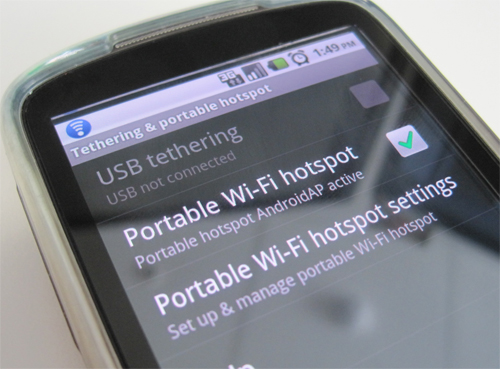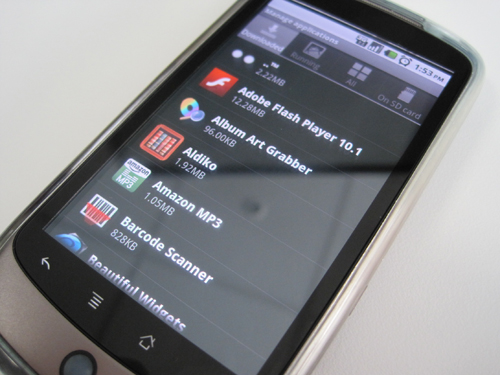Android 2.2: The official verdict
We put Froyo through its paces

The dust has barely settled on Google’s Android 2.2 announcement and already the update is being pushed out to lucky Nexus One owners – us included.
No doubt you’ve been poring over the feature list and wondering just what this new update will bring to the table, but ponder no longer – we’ve been putting Froyo through its paces over the weekend and have the answers you’re looking for.
PerformanceFirst up, 2.2 is blisteringly fast. So fast, in fact, that it feels like you’re using an entirely new device. Much of this is down to the inclusion of the JIT (Just In Time) compiler, although Google’s engineers have obviously been hard at work with other behind-the-scenes optimisations.
As a result, just performing basic tasks such as browsing the web, moving between applications, and viewing the Android Market all benefit from speed increases.
You’ll also find that 2.2 frees up much more RAM than 2.1: previously we’d have around 30-50MB of a RAM spare but post-Froyo that has been boosted to 150-200MB. More RAM obviously means better overall performance.
Apps
Naturally, an increase in speed also means that your apps run a lot better. To put the update through its paces we loaded up the epic 3D blaster ExZeus and were astonished by the increase in speed.
.jpg)
Other processor-intensive programs – such as SNES emulator SNesoid – also ran more smoothly. Google has worked wonders with the Android code and managed to extract additional power by cleaning up the code and implementing enhancements.
The Android Market has also undergone some welcome changes: it’s finally possible to update all apps rather than having to do them separately. What’s more, you can now enable auto-updating so that when a new version comes out it simply downloads the new edition without bothering you with the boring specifics.
Tethering
One of the big stories surrounding Android 2.2 is the introduction of tethering over wi-fi. As expected, this works painlessly: you simply enable the feature within the phone’s Wireless Settings menu and then connect using your laptop or other wireless device.
Of course, it’s somewhat limited because you’re still connecting at 3G speeds. Sites take a while to load properly, but if you’re stuck in a location without any internet access and you desperately need to get online, this could prove to be a lifesaver.
It remains to be seen how the various network operators will respond to this feature being implemented in all future Android phones, as many currently charge a premium for customers wishing to exploit their handset’s connectivity to link other devices to the web, but for the time being it’s a real bonus for Android fans.
Browser boost
There was a time when the default Android browser was seen as something of a laughing stock with users, but with Froyo Google has made dramatic gains in this field. The most obvious is the inclusion of support for Flash sites (you’ll have to download Flash from the Android Market first, however).
It’s not just interactive content which makes the browser experience so positive in 2.2, though: Google has integrated Chrome's V8 JavaScript engine to grant additional brunt. In simple benchmark tests the stock Android browser easily beats rival programs – such as Dolphin Browser HD and SkyFire 2.0 – in terms of page-load speed and stability.
Opening up the SD cardOne of the Android platform’s biggest weaknesses has been the restriction of installing apps to a small amount of internal RAM on the phone itself, rather than straight to the SD card.
Android 2.2 now allows you to store your apps on external media, although it’s worth noting that the app has to support the feature for this to be possible. At present few apps actually offer the ability to do this, but it should prove to be an indispensible option as time goes on.
This means that you can now have more content on your phone than ever, although it remains to be seen if it will result in larger, more visually impressive games.
Developers may still choose to keep their titles as small as possible to ensure that the largest number of people can access them (lest we forget that many Android users are still stuck on 1.5 or 1.6).
Google Mail improvementsThis is one feature which has gone under the radar a little but is well worth mentioning nonetheless. Google Mail is now integrated more closely with your contacts: if you have a photo image assigned to a contact then it will appear when they email you.
.jpg)
You’ll also be able to make use of the quick-selection pop-up box which was introduced with 2.1. Tapping a contact’s image brings up all of the possible options or that person – including calling them, sending a text message, viewing their Facebook account, or checking their status on Twitter.
…and now the bad newsIt’s not all positive in the world of Android 2.2, however. The most obvious issue is incompatibility: many apps haven’t been updated for 2.2 yet, so you may find that many of your favourite pieces of software either don’t function as they should or refuse to open at all.
This will obviously change over time as devs update their apps, but for the time being it’s something of annoyance, especially if you can no longer get access to essential software.
Another issue we’ve noticed is a reduction in touchscreen sensitivity. Since installing Android 2.2 we’ve experienced a worrying number of undetected swipes when navigating the main menu of the phone.
Also, those of you hoping that Froyo would fix the problem of erratic multi-touch on HTC-produced devices are going to be a little disappointed. The screen still fails to accurately track two different touch points which lends credence to the theory that the issue is related to hardware and cannot be solved through software updates.
The verdictThere’s no question that Android 2.2 is an incredible update. The performance increase between this and 2.1 is nothing short of amazing: the extra power that Google has managed to wring out of the already impressive Nexus One hardware makes it feel like you’re using an entirely new phone.
To compare it to the difference between the iPhone 3G and 3GS isn’t as far-fetched as it might seem.
It’s not just a matter of boosting performance, though. The introduction of Flash means that the web is now much more accessible on Android and opens up the possibility of playing browser-based games.

However, it’s not just gamers who benefit with Froyo – business users will love the ability to tether their laptops to their phones and the enhanced support for Microsoft Exchange should help Google’s mobile OS keep up with the BlackBerries of this world.
Who will get it, and when?Nexus One owners should have had Froyo pushed out to their phones via an over the air update but for everyone else the wait could be a little more protracted.
The Motorola Droid is a 'Google Experience' handset and therefore a likely candidate for early updating, but other flagship devices won’t be so lucky.
The recently launched HTC Desire – which is arguably the leading Android phone in the world right now – won’t be updated until the second half of this year, according to its manufacturer. This is because it uses HTC’s propriety Sense UI which means it takes longer to integrate with Google’s stock Android code.
Indeed, with many Android phones still patiently waiting for Android 2.1 to hit, it’s looking increasingly likely that not every user will have the chance to sample the delights of Froyo this year.
Fragmentation continues to be a pressing problem for Google, but with Android 3.0 already on the roadmap, the company doesn’t seem to be overly concerned.
Still, there’s no escaping the fact that Froyo is a massive step forwards for Android and should enable the format to keep up with the impending launch of Apple’s 4G iPhone.
